Chemnitz Schloss Branch, Chemnitz District
Roger P. Minert, In Harm’s Way: East German Latter-day Saints in World War II (Provo, UT: Religious Studies Center, Brigham Young University, 2009), 184-90.
The Schloss [palace] Branch was by far the smaller of the two Latter-day Saint branches in Chemnitz in 1939. It had 186 members of record, while the Center Branch had 469. The Schloss Branch was named after the palace sitting on a hill in the northwest section of the city. The address of the rooms rented by the Schloss Branch was Winklerstrasse 19, almost exactly one mile from downtown Chemnitz (the Markt).
| Chemnitz Schloss Branch[1] | 1939 |
| Elders | 8 |
| Priests | 5 |
| Teachers | 5 |
| Deacons | 11 |
| Other Adult Males | 45 |
| Adult Females | 101 |
| Male Children | 5 |
| Female Children | 6 |
| Total | 186 |
As was the case with so many other LDS branches in Germany at that time, the Schloss Branch met in a Hinterhaus on both floors. According to branch member Ruth Schumann (born 1928):
There was one large room upstairs with dividers. Downstairs there was a cloakroom that could be used as a classroom. The rest of the downstairs was a plumber’s workshop. The Bruno Schreiter family lived in the same building. They let the Church rent one of their rooms with a small balcony for a classroom for Sunday School, Primary, and Relief Society.[2]
Sunday School was the first meeting of the day, beginning at 10:00 a.m. Sacrament meeting was held in the evening. Relief Society and priesthood meetings were held on Monday evenings, MIA on Tuesday evenings, and Primary on Wednesday afternoons after school. Thursday evenings were used for choir practice.
In a Chemnitz District conference of 1938, Hans Schumann helped some of the men to dress as Latter-day Saint prophets of the years 1830 to 1938. He and his sister, Marianne, used hair, wigs, and makeup from their parents’ beauty parlor and barbershop. It took weeks to make the preparations. Ruth Schumann recalled that district president Karl Göckeritz, the only local member who owned an automobile, drove the actors one by one from the salon to the meetinghouse before the program.
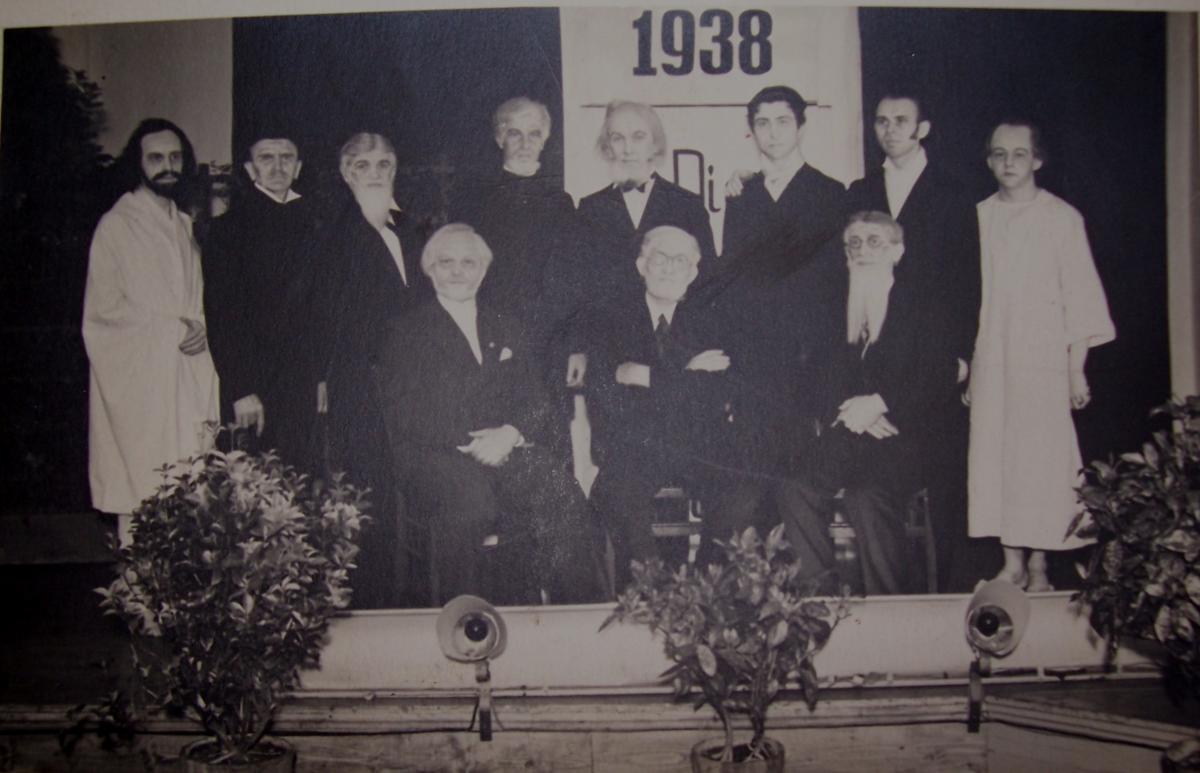 Chemnitz District priesthood holders dressed to represent heavenly messengers and latter-day prophets for a program in 1938. (R. Schumann Hinton)
Chemnitz District priesthood holders dressed to represent heavenly messengers and latter-day prophets for a program in 1938. (R. Schumann Hinton)
Ruth Schumann was eleven years old when World War II began. Fortunately, Chemnitz was spared the sufferings inflicted on many German cities for most of the war. Ruth recalled having enough food to eat during the war, but dairy products were hard to find, and fruit became a rarity. Because of the fruit shortage, each child was given a vitamin C tablet in school every day.
Christa Glauche (born 1923) recalled a problem with politics in Germany during the war:
My parents were not politically involved in anything. They were very active in Church, and therefore there was no time for any other activities. My mother’s brother often talked about politics and my parents did not respond; my father got very anxious because he did not like talking about this topic. My uncle was not a member of the Church.
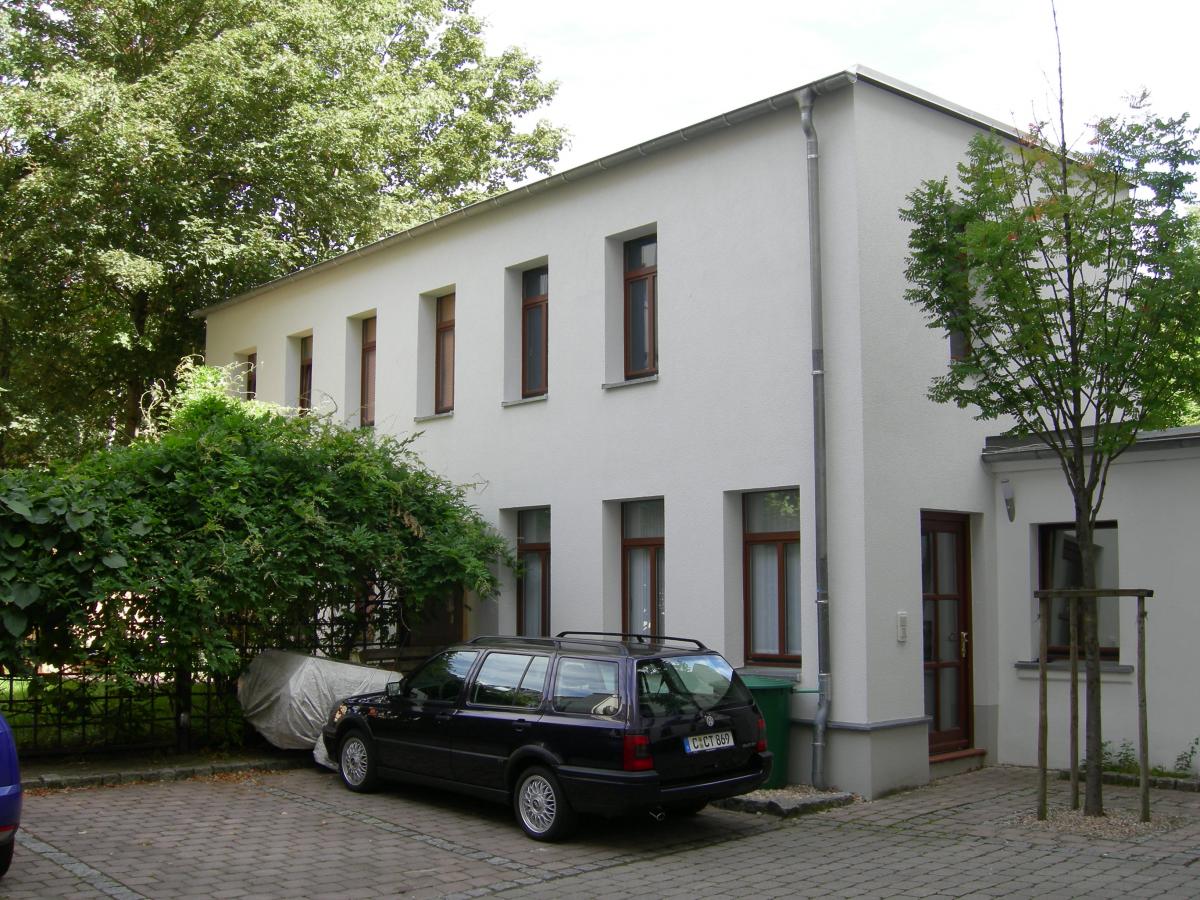 Schloss Branch meetinghouse—the Hinterhaus at Winklerstrasse 19 as it appeared in 2008
Schloss Branch meetinghouse—the Hinterhaus at Winklerstrasse 19 as it appeared in 2008
Some Saints in Germany found it possible to express brotherly love regarding the enemy in wartime, as is clear from Christa Glauche’s recollection of her mother:
When the war started, my brothers and male cousins had to serve in the war, and my mother got sick because she was so worried about everybody. She also cried when a British ship was sunk because she always thought about how all the boys on the ship also had mothers waiting for them to come back home.
Christa Glauche’s mother died in 1942, and Christa moved with her father to Annaberg-Buchholz, where she lived until 1946. They were welcomed into the large LDS branch there.
Ruth Schumann’s father, Rudolf, was under pressure to join the Nazi Party. According to his son, Hans, he gave the party representatives this carefully worded refusal: “I never have broken any law of the land and I will never do that. However, I cannot join any party because I cannot offend any of my clients, who belong to a different party or faith than I belong to. I will be neutral.”
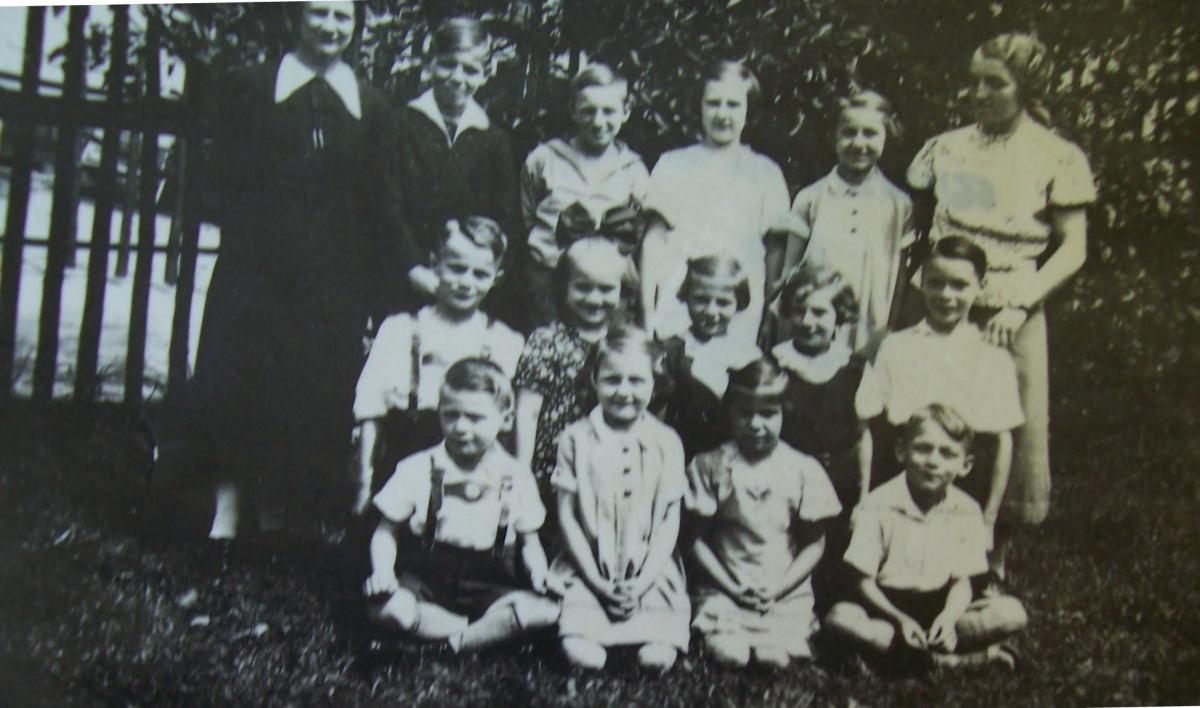 A class of the Chemnitz Schloss Branch Sunday School in 1938 (R. Schumann Hinton)
A class of the Chemnitz Schloss Branch Sunday School in 1938 (R. Schumann Hinton)
Air raids were not a serious problem in Chemnitz until 1945, but there were plenty of false alarms. On one occasion, the alarm went off during sacrament meeting. According to Ruth: “The choir was singing a very wonderful, comforting song from the ninety-first psalm, and the branch president said, ‘We’re not going to go to a shelter. We’re going to stay right here.’ And the planes went somewhere else. I do not believe that this was a false alarm.”
The date March 5, 1945, will forever be etched in the minds of surviving Chemnitz residents. Ruth Schumann remembered that three attacks from the air occurred on that day. The Schumann home was damaged at about noon in the first attack; two bedrooms upstairs were destroyed, but the beauty parlor on the street level survived. The electrical and water systems were nonfunctional. At 8:00 p.m., another attack occurred, and the family hurried around the corner to seek refuge in the basement with the Schneiders. As Ruth recalled:
It was horrible. It was terrible. My dad made me lie on the floor, and above me was my brother and my sister and my mom and my dad, and then he put his arms around us. After a while, Brother Schneider and my dad went upstairs and saw that everything was on fire, and they decided that we had to get out of there. There was snow on the ground and that helped against fires from incendiary bombs. That was on a Monday. The day before, Sunday, Brother Schneider (who was in the branch presidency) had said: “Brothers and Sisters, I don’t know why I’m telling you this, but tomorrow morning I want you to check out your hand wagons [Bollerwagen or Leiterwagen], to see if they’re all in working condition.”
Brother Schneider was clearly referring to the preparations made by several million Germans who already had fled from or been driven out of the eastern territories invaded by the Red Army.
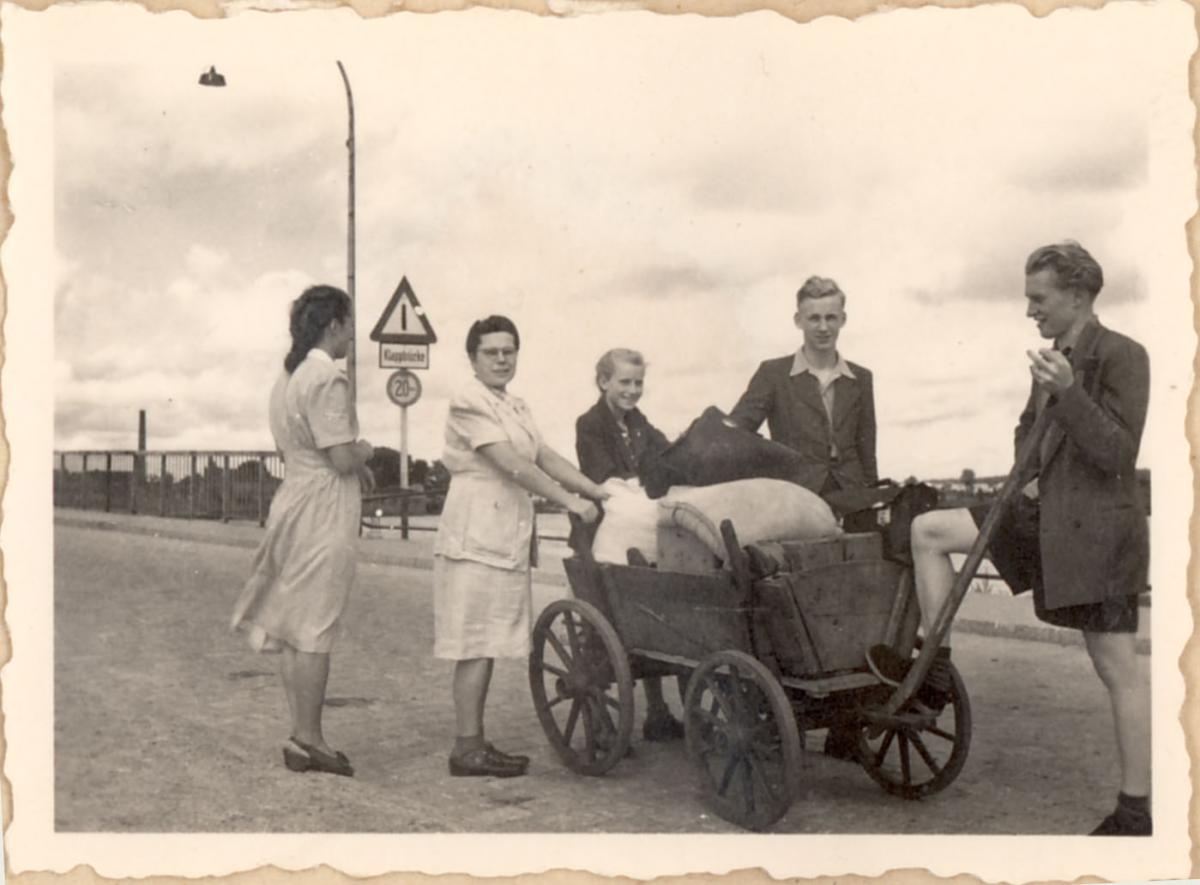 The typical Bollerwagen served many thousands of German refugees in the last years of the war. (C. Glauche Schlünz)
The typical Bollerwagen served many thousands of German refugees in the last years of the war. (C. Glauche Schlünz)
By Tuesday, March 6, several thousand people in Chemnitz had perished, and many thousands more were homeless, among them several members of the Schloss Branch who then put those little wagons to good use. The Schumanns headed out of town to Auerswalde, about five miles north of Chemnitz, where they had owned a vacation cabin (“a shack”) for some years and were known among the neighbors. The Schumanns were still in their shack six weeks later when the war came to an end in that part of Saxony. As Ruth later related:
I looked out of the window, and I saw American tanks approaching from the other slope, across the river. . . . And my mother put out a white tablecloth on the clotheslines. And here came German soldiers. I think some of them were SS, and they said if my mother would not take in the tablecloth they would kill my papa. So we had to take it in. . . . Then the Americans started shooting at us.
The family left their shack and hid for a while. When the firing was over, they returned to find about thirty holes in the shack. “We would have either been killed or terribly wounded,” Ruth claimed. The Schumann family eventually returned to Chemnitz, as did their son Johannes, who was released in 1946 as a prisoner of war in the Soviet Union.
The Schumanns were together, but Ruth recalled that many families could not be reunited: “I will never forget the messages written [often in chalk] on bombed-out houses, like: ‘Mother, where are you? I am back and could not find you. Your son . . .’ Other messages were more encouraging: ‘We are alive! You can find us at [address].’”
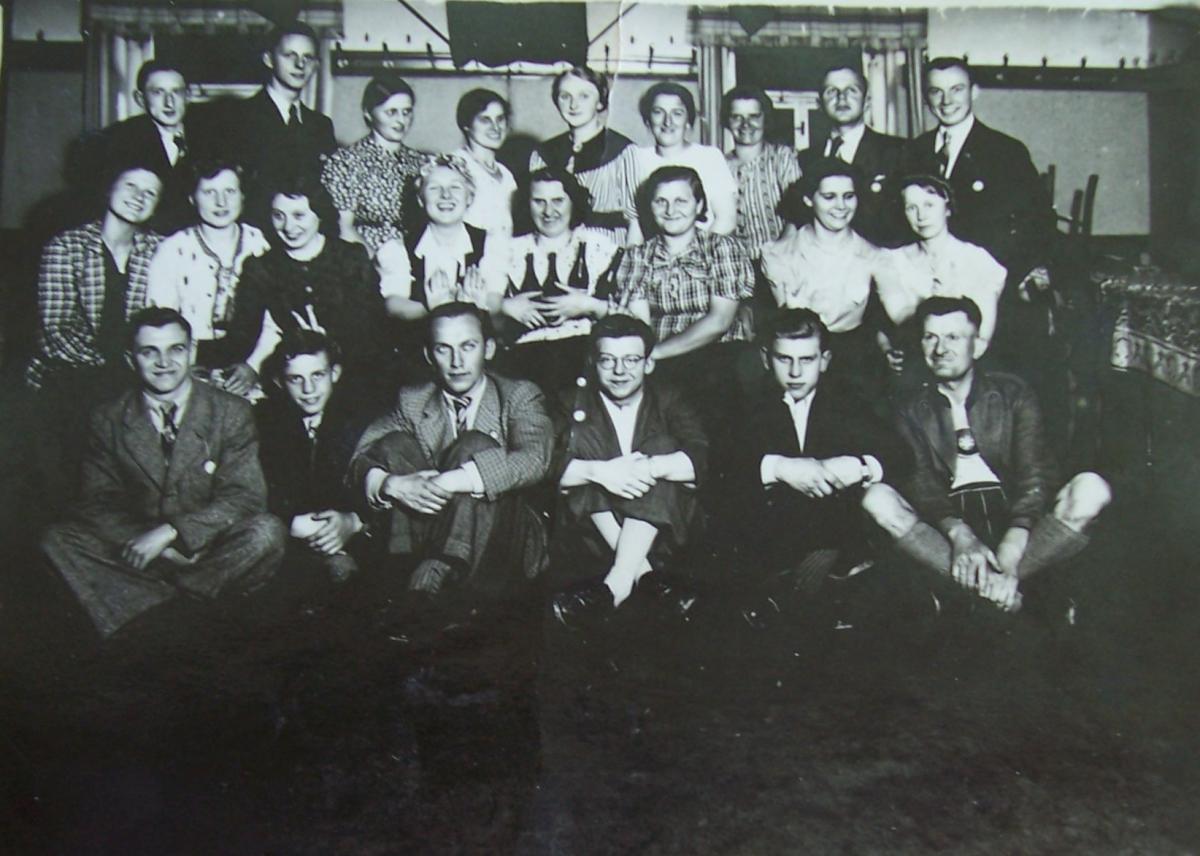 Young singles and married couples of the Chemnitz Center and Schloss Branches in 1942 (R. Schumann Hinton)
Young singles and married couples of the Chemnitz Center and Schloss Branches in 1942 (R. Schumann Hinton)
The meeting rooms on Winklerstrasse had survived the war and soon became the venue for the Chemnitz Center Branch as well. Until other rooms could be found later in 1945, consecutive meetings were held for the two branches. However, the windows had been knocked out and could not be replaced for some time. The members covered the window spaces with cardboard and wood. This made it very difficult to see when the power was out, so the members used candles to provide light to see their hymnbooks and to read the sacramental prayers.[3]
Despite the fact that both Chemnitz branches had suffered heavy losses in soldiers and civilians, both branches were active and determined to carry on in faith once peace was restored.
In Memoriam
The following members of the Chemnitz Schloss Branch did not survive World War II:
Emma Auguste Wilhelmine Albrecht b. Waldenburg, Chemnitz, Sachsen 3 Apr 1851; dau. of Friedrich Wilhelm Albrecht and Wilhelmine Heinicke; bp. 31 Jan 1920; conf. 1 Feb 1920; m. 26 Jan 1879, Franz Louis Beckmann; d. heart failure Chemnitz, Chemnitz, Sachsen 14 Apr 1941 (Sonntagsgruss, No. 22, 1 Jun 1941, 88; CHL LR 1933 21, No. 4; IGI)
Elfriede Liddy Barth b. Chemnitz, Chemnitz, Sachsen 22 Nov 1926; dau. of Reinhold Herbert Barth and Liddy Camilla Schlicke; bp. 31 Aug 1935; conf. 31 Aug 1935; k. air raid Chemnitz 5 Mar 1945 (Spieler; CHL LR 1933 21, No. [6 or 282] and LR 4326 22, No. 7; IGI)
Ilse Elfriede Barth b. Chemnitz, Chemnitz, Sachsen 25 Aug 1931; dau. of Reinhold Herbert Barth and Liddy Camilla Schlicke; bp. 24 Aug 1940; conf. 24 Aug 1940; k. air raid Chemnitz 5 Mar 1945 (CHL LR 1933 21, No. 235 or 511; IGI)
Selma Ida Beckmann b. Langenchursdorf, Chemnitz, Sachsen 5 Apr 1866; dau. of Johann Gottfried Beckmann and Caroline Wilhelmine Polster; bp. 15 Jan 1910; conf. 15 Jan 1910; m. 16 Aug 1891, Albin Stenzel; 1 child; d. heart ailment Chemnitz, Chemnitz, Sachsen 14 Jan 1941 (Sonntagsgruss, No. 6, 9 Feb 1941, 24; FHL Microfilm 245274, 1935 Census; CHL LR 1933 21, No. 138; IGI)
Paul Lothow Boehme b. Frankenberg 13 Jul 1894; son of Emil Jaukeojoll Boehme and Marie E. Jahn; bp. 14 Aug 1927; conf. 14 Aug 1927; m. 11 Oct 1924, Mowther Adelheit Zimmermann; d. accident 3 Sep 1943 (CHL LR 4326 22, No. 37)
Meta Ella Brueckner b. Geyersdorf, Annaberg, Sachsen 1 Aug 1898; dau. of Carl Emil Brueckner and Anna Auguste Meyer; bp. 14 Jan 1914; conf. 14 Jan 1914; lost 20 Jan 1941 (CHL LR 1933 21, No. [204 or 480]; IGI)
Johannes Emil Franke b. Chemnitz, Chemnitz, Sachsen 30 Apr 1910; son of Max Goers and Liddy Franke; bp. 6 Dec 1919; conf. 7 Dec 1919; m.—Liesel; d. wounds inflicted by shrapnel 18 Jun 1942 (CHL LR 1933 21, No. 28; IGI)
Bertha Minna Glaesser b. Weißbach, Chemnitz, Sachsen 8 Oct 1860; dau. of Johann Gottlieb Glaesser and Johanne Caroline Nestler; bp. 9 Apr 1910; conf. 9 Apr 1910; m. Weißbach 18 Feb 1886, Robert Oswald Glaesser; 15 children; d. stroke Chemnitz, Chemnitz, Sachsen 14 May 1941 (CHL LR 1933 21, No. [52 or 328]; IGI; AF)
Johann Friedrich Max Godat b. Königsberg, Ostpreussen, Preussen 4 Feb 1881; son of Johann Friedrich Max Godat and Bertha Friederike Lindemann; bp. 31 Jan 1920; conf. 1 Feb 1920; m. Chemnitz, Chemnitz, Sachsen 7 Oct 1913, Anna Marie Schulz; d. heart failure Chemnitz 27 Feb 1942 (CHL LR 1933 21, No. 41; IGI)
Anna Marie Haubold b. Gablenz, Chemnitz, Sachsen 21 Apr 1889; bp. 16 Nov 1913; conf. 16 Nov 1913; lost 20 Jan 1941 (CHL LR 1933 21, No. [220 or 496]; IGI)
Johannes Heidler b. Chemnitz, Chemnitz, Sachsen 11 Jun 1927; son of Emil Heidler and Anna Maria Gleisberg; bp. 10 Aug 1935; conf. 10 Aug 1935; ord. deacon 14 May 1941; k. in battle 23 Apr 1945 (Puppitz-Ricker; CHL LR 1933 21, No. 71 or 347; IGI; AF)
Karl Gottfried Heinrich b. Lengefeld, Chemnitz, Sachsen 29 May 1900; son of Karl Albin Heinrich and Aurelie Jenny Graichers; bp. 8 Jul 1927; conf. 8 Jul 1927; ord. deacon 10 Jun 1929; ord. teacher 1 Mar 1931; ord. priest 1 Jul 1934; ord. elder 14 Jul 1940; m. Grosshartmannsdorf, Dresden, Sachsen 6 Aug 1927, Anna Lina Haertig; 3 children; d. nerve paralysis Chemnitz, Chemnitz, Sachsen 16 Nov 1944 (CHL LR 1933 21, No. 71; IGI; PRF)
Willi Hoehnl b. Chemnitz, Chemnitz, Sachsen 28 Dec 1918; son of Isidor Ambros Hoehnl and Ida Bertha Hoyer; bp. 15 Apr 1927; conf. 15 Apr 1927; m. Chemnitz 24 Dec 1940, Luise Schubert; 1 child; d. tuberculosis 7 May 1940 (CHL LR 1933 21, No. 255; IGI; AF)
Johanne Charlotte Hunger b. Chemnitz, Chemnitz, Sachsen 6 Mar 1908; dau. of Ernst Hermann Hunger and Pauline Czaja; bp. 3 Feb 1934; conf. 4 Feb 1934; d. pneumonia 28 Sep 1940 (CHL LR 1933 21, No. 203; IGI)
Olga Lina Kaiser b. Hartmannsdorf, Chemnitz, Sachsen 8 Jul 1866; dau. of Ernst Gotthilf Rudolph Kaiser and Theresia Pauline Liebert; bp. 20 Dec 1922; conf. 20 Dec 1922; m. Hartmannsdorf, Chemnitz, Sachsen 18 May 1891, Ernst Bruno Nier; d. old age 6 Aug 1943 (CHL LR 1933 21, No. 128; IGI; AF; PRF)
Gerhard Heinz Kinder b. Chemnitz, Chemnitz, Sachsen 27 Apr 1920; son of Emil Adolf Kinder and Martha Hedwig Uhlig; bp. 23 Jun 1932; conf. 23 Jun 1932; k. in battle near Smolensk, Russia 18 Feb 1942 (CHL LR 1933 21, No. 90; IGI)
Hellmut Kinder b. Chemnitz, Chemnitz, Sachsen 24 Nov 1911; son of Martha H. Uhlig; ord. deacon; k. in battle (W. Rohloff; A. Langheinrich)
Karl Gustav Kuehn b. Hermsdorf, Görlitz, Schlesien, Preussen 12 Oct 1866; son of Johann Friedrich Kuehn and Maria Rosina Muehle; bp. 29 Jan 1902; m. 18 May 1891, Anna Luise Auguste Hansche; 2 children; 2m. Leschwitz, Görlitz, Schlesien, Preussen 17 Nov 1895, Pauline Selma Hansche; 3 children; d. Leopoldshain, Görlitz, Schlesien, Preussen 25 Jul 1943 (IGI)
Karl Friedrich Gustav Kuehn b. Leopoldshain, Görlitz, Schlesien, Preussen 4 May 1909; son of Karl Gustav Kuehn and Pauline Selma Hansche; bp. 23 Oct 1917; m. 17 Nov 1933; d. 8 Mar 1944 (IGI)
Alma Martha Lang b. Buchholz, Chemnitz, Sachsen 4 Jun 1880; dau. of Karl Herm. Lang and Emilie Junghuas; bp. 25 Jun 1921; conf. 25 Jun 1921; m. 28 Jan 1905, Richard Moritz Schrieber; d. diabetes 16 Jan 1945 (CHL LR 1933 21, No. 152; IGI)
Karl Paul Langer b. Ehrenfriedersdorf, Sachsen 20 Jan 1867; son of Karl Hermann Langer and Wilhelmine Haenchen; bp. 15 Aug 1930; conf. 15 Aug 1930; ord. deacon 6 Dec 1931; ord. teacher 21 Aug 1933; ord. priest 16 Jul 1939; m. 16 Jan 1904, Anna Marie Seidel (div); 2m.; 3m.; d. heart ailment 1 Jan 1942 (CHL LR 1933 21, No. [109 or 385] and [281 or 641]; Karl Goeckeritz; IGI)
Anna Luise Lungwitz b. Kappel, Chemnitz, Sachsen 13 Sep 1884; dau. of Otto Bruno Lungwitz and Anna Marie Fritzsch; bp. 17 Sep 1921; conf. 17 Sep 1921; m. Chemnitz, Chemnitz, Sachsen 27 Dec 1907, Max Arno Glauche; 5 children; d. diabetes Chemnitz-Kappel, Sachsen 18 May 1942 (CHL LR 1933 21, No. 51; IGI; PRF)
Ewald Friedrich Mehner b. Oberweschnitz, Stollberg, Chemnitz, Sachsen 19 Jan 1869; son of Gottlieb Mehner and Christine Caroline Richter; bp. 3 Feb 1914; conf. 3 Feb 1914; d. asthma Chemnitz, Chemnitz, Sachsen 7 Apr 1941 (Sonntagsgruss, No. 22, 1 Jun 1941, 88; CHL LR 1933 21, No. 117; IGI)
Friedrich Oswald Werner Morgenstern b. Leipzig, Leipzig, Sachsen 12 Mar 1918; son of Friedrich Oswald Morgenstern and Frieda Selma Anna Pertuch; bp. 8 May 1928; conf. 8 May 1928; soldier; d. found dead in hotel 19 Dec 1942 (CHL LR 1933 21, No. 116; IGI)
Frieda Selma Anna Pertuch b. Ortelsdorf, Chemnitz, Sachsen 2 Oct 1880; dau. of Adolf Hermann Pertuch and Amalia Wilhelmine Liebers; bp. 17 Dec 1910; conf. 17 Dec 1910; m. Niederlichtenau, Chemnitz, Sachsen 8 Nov 1903, Friedrich Oswald Morgenstern; 4 children; d. heart attack Chemnitz, Chemnitz, Sachsen 6 Feb 1942 (CHL LR 1933 21, No. 114; IGI)
Anna Hedwig Peter b. Efurt, Sachsen 31 Apr 1899; dau. of Johann Ernst Hermann Peter and Klara Hedwig Fischer; bp. 1 Nov 1924; conf. 1 Nov 1924; m. 7 May 1935, Fritz Junghanns; k. air raid 8 Mar 1945 (CHL LR 1933 21, No. 135 or 479; IGI)
Christiane Karoline Petzold b. Pillmannsgrün, Voigtland, Sachsen 14 Jun 1853; dau.. of Carl Christian Petzold and Caroline Christiane Koelbel; bp. 12 Jun 1920; conf. 12 Jun 1920; m. Plauen, Sachsen 2 Jun 1877, Emil Ernst Mueller; 12 children; d. old age Waldenburg, Chemnitz, Sachsen 17 Nov 1941 (CHL LR 1933 21, No. 124; IGI)
Ernst Hans Pöcker b. Chemnitz, Chemnitz, Sachsen 19 Aug 1912; son Ernst Max Pöcker and Helen Klara Lindner; bp. 6 Oct 1923; conf. 7 Oct 1923; ord. deacon 5 Oct 1930; m. 31 Aug 1935, Fanny Elsa Weiser; soldier; k. in battle Russia 22 Jun 1941 (Sonntagsgruss, No. 28, 21 Sep 1941, 112; CHL LR 1933 21, No. 132; IGI)
Rose Ruthild Richter b. Chemnitz, Chemnitz, Sachsen 9 Jul 1927; dau. of Max Otto Richter and Rosa Gertrud Seipp; bp. 5 Sep 1941; conf. 5 Sep 1941; d. pleurisy 1945 (CHL LR 1933 21, No. 298 or 658; IGI)
Camillo Johannes Schoenfeld b. Limbach, Chemnitz, Sachsen 24 Nov 1913; son of Camillo Rinaldo Schoenfeld and Hedwig Helene Mueller; bp. 18 Sep 1925; conf. 18 Sep 1925; m. 9 Dec 1939; lance corporal; k. in battle Buimer, Bjelgord, Russia 18 Aug 1943 (CHL LR 1933 21, No. 167; IGI; www.volksbund.de)
Harold Joachim Schoenfeld b. Chemnitz, Chemnitz, Sachsen 19 May 1927; son of Camillo Rinaldo Schoenfeld and Hedwig Helene Mueller; bp. 31 Aug 1935; conf. 31 Aug 1935; k. in battle by Gueben 4 Mar 1945 (CHL LR 1933 21, No. 169; IGI)
Anna Marie Schulz b. Wiesenburg, Zwickau, Sachsen 18 Mar 1877; dau. of Hermann Benjamin Schulz and Marie Auguste Heydel; bp. 24 Sep 1917; conf. 24 Sep 1917; m. Chemnitz, Chemnitz, Sachsen 7 Oct 1913, Johann Friedrich Max Godat; d. stomach problems Chemnitz 15 Mar 1942 (CHL LR 1933 21, No. 40; IGI; AF)
Anna Marie Seidel b. Ehrenfriedersdorf, Sachsen 27 Aug 1872; dau. of Karl August Seidel and Christiane Paule Haehnel; bp. 15 Aug 1930; conf. 15 Aug 1930; m. 16 Jan 1904, Karl Paul Langer (div); k. air raid Chemnitz, Chemnitz, Sachsen 5 Mar 1945 (CHL LR 1933 21, No. 110 or 386; IGI)
Kurt Erich Wagner b. Chemnitz, Chemnitz, Sachsen 5 Apr 1910; son of Ernst Bruno Wagner and Anna Lina Thomas; bp. 1 May 1920; conf. 1 May 1920; ord. deacon 18 Jun 1928; m. 25 Sep 1937; rifleman; k. in battle by Mekensia, Sewastopol, Russia 18 Dec 1941 (CHL LR 1933 21, No. 184; IGI; www.volksbund.de)
Marie Emilie Winkler b. Lunzenau, Chemnitz, Sachsen 14 Nov 1873; dau. of Robert Winkler and Auguste Freigang; bp. 21 Oct 1919; conf. 22 Oct 1919; m. 9 Mar 1902, Joseph Hamperl; d. 9 Dec 1940 (CHL LR 1933 21, No. 82 or 358; IGI)
Notes
[1] Presiding Bishopric, “Financial, Statistical, and Historical Reports of Wards, Stakes, and Missions, 1884–1955,” CR 4 12, 257.
[2] Ruth Schumann Hinton, interview by Jennifer Heckmann and Erin Clark, Lehi, Utah, June 23, 2006.
[3] Similar lighting problems persisted in many branches in Germany at the end of the war. This practice likely gave rise to the rumor that German Saints were using candles (or even incense) at the sacrament table as part of some forbidden ritual. Some members propagating those rumors in foreign countries founded the “forbidden rituals” on the fact that the German Latter-day Saints had been isolated from priesthood leadership in Salt Lake City for nearly four years.
